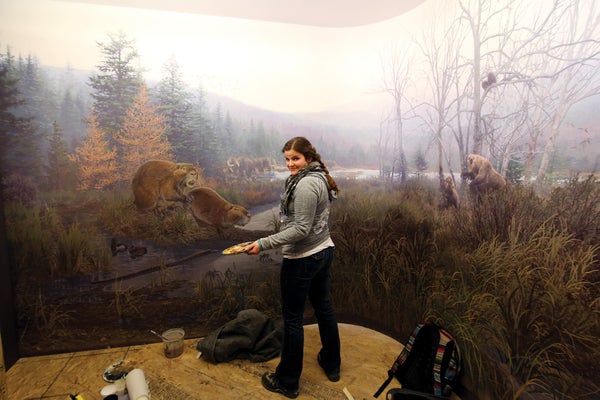August 20, 2024
4 min read
Contributors to Scientific American’s September 2024 Issue
Writers, artists, photographers and researchers share the stories behind the stories

Tim Quady/Blue Rhino Studio
Beth Zaiken
What Was It Like to Be a Dinosaur?
Since childhood, Beth Zaiken (above) has been enamored by old-school natural history museum exhibits—the ones that use visual tricks to make sculptures and murals behind a glass panel feel like expansive, immersive worlds. “It’s a totally magical illusion,” she says. “It’s like the painting coming alive.” Today Zaiken designs similar murals for museum exhibits, often featuring dinosaurs, mammoths, or other prehistoric fauna. For this month’s cover story, written by evolutionary biologist Amy M. Balanoff and paleontologist Daniel T. Ksepka on what it was like being a dinosaur, she brought the world of a T. rex and a Triceratops to life.
Zaiken enjoys the challenge of illustrating bygone eras: you have to “imagine Earth in different time periods and transport yourself there.” She lives in Minnesota on a back channel of the Mississippi River and describes herself as a “totally aquatic creature”—one who loves fishing, canoeing and kayaking. The river is home to an abundance of catfish, and she also keeps these native freshwater fish as pets in her 125-gallon aquarium. And she has four dogs and two snakes. “If you give me half a chance, I will fall in love with anything that moves,” Zaiken says.
On supporting science journalism
If you’re enjoying this article, consider supporting our award-winning journalism by subscribing. By purchasing a subscription you are helping to ensure the future of impactful stories about the discoveries and ideas shaping our world today.
Alec Luhn
Out of Thin Air
For nearly a decade Alec Luhn lived and worked in Russia as a news correspondent. He traveled all over the country, reporting on everything from politics to sports to science. One of his first climate stories was on how thawing permafrost is destroying Arctic cities. Later, he wrote about a town taken over by polar bears and about reindeer herders displaced by the oil industry. His time in Russia made it clear to him that climate change was “the big story of our era,” says Luhn, who is now a freelance climate journalist based in England.
For his feature story in this issue, Luhn traveled to California, Texas and Louisiana to visit the sites of current and future direct-air-capture (DAC) plants. This technology promises to suck carbon dioxide from the air, leaving it ready to be sequestered in the ground, but it is costly. Its use is also loaded with important ethical questions, which makes the tech “extremely contentious,” Luhn says. “Is DAC going to save the world by helping us compensate for those last few billion tons of CO2, or is it just going to perpetuate the fossil-fuel industry that we’re all so heavily reliant on today?”
Veronica Falconieri Hays
A New Type of Pain Pill
As a medical illustrator, Veronica Falconieri Hays specializes in both the very complicated and the very small. “Molecular biology is my jam,” she says. Ever since studying biology in college, she has loved to peer through powerful microscopes at the molecules and structures that underpin life. “It’s easy to get lost in” these complex worlds, she says. “You just kind of want to keep looking.”
For every project, Hays learns about a new area of science and tries to wrangle that information into a visual representation that will “bring [you] along to learn what I just learned.” In this month’s feature on new pain medications, written by science journalist Marla Broadfoot, Hays illustrated how ion channels allow nerves to fire—and how sodium channel blockers can target them to stop pain at its source.
When Hays worked for the National Cancer Institute in a cell biology lab from 2014 to 2018, scientists were still trying to understand the structure of these ion channels. So she was particularly interested to learn how new drugs are able to target them. “I’m really, really hopeful that these [new medications] are going to help a lot of people who deal with pain in their everyday life,” Hays says.
Lydia Denworth
Improving with Age
In high school and college, Lydia Denworth was more of a history and English person—“I took the minimum amount of science classes possible,” she says. Yet in her career as a journalist, she often found herself covering health-related topics. Her first book, published in 2009, followed the scientists who uncovered the toxic effects of lead. “I was really proud of it,” she says. From there Denworth began to delve more into science reporting, often with a focus on neuroscience. “Science felt important. It felt like stories worth telling.” As it turned out, her lack of prior knowledge was an asset that allowed her to ask better questions and explore better explanations.
Now a contributing editor at Scientific American, Denworth splits her time between Brooklyn and her family’s farm in central New York State. In her Science of Health column, she writes about new or interesting science that answers questions readers may have about their own health. In this issue, she dispels the pervasive myth that aging always comes with cognitive decline. “There’s just this real cultural stereotype that everybody declines cognitively as they age,” Denworth says. But in reality, “if you have a healthy brain, many people don’t decline almost at all.”

